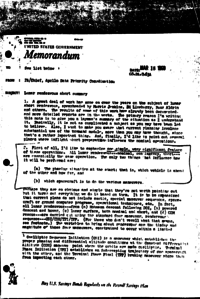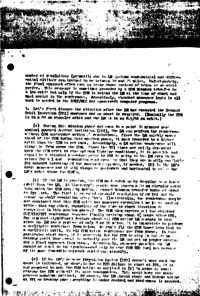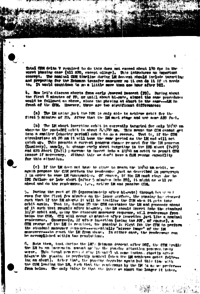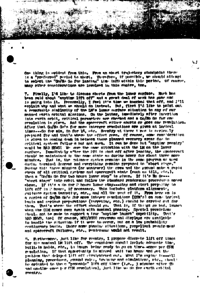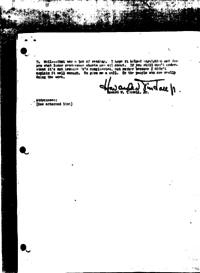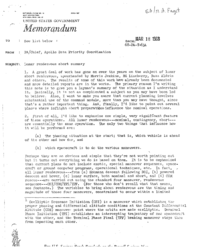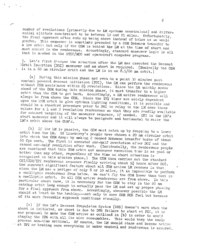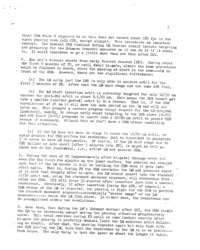See list belowMAR 18 196868-PA-T-63APA/Chief, Apollo Data Priority CoordinationLunar rendezvous abort summary
1. A great deal of work has gone on over the years on the subject of lunar abort rendezvous, spearheaded by Morris Jenkins, Ed Lineberry, Buzz Aldrin and others. The results of some of this work have already been documented and more detailed reports are in the works. The primary reason I'm writing this note is to give you a layman's summary of the situation as I understand it. Basically, it is not as complicated a subject as you may have been led to believe. Also, I want to make you aware that current planning involves substantial use of the command module, more than you may have thought, since that's a rather important thing. And, finally, I'd like to point out several places where inflight abort preparations influence the nominal operations.
2. First of all, I'd like to emphasize one simple, very significant feature of these operations. All lunar rendezvous—nominal, contingency, abort— are essentially the same operation. The only two things that influence how it will be performed are:
(a) The phasing situation at the start; that is, which vehicle is ahead of the other and how far, and
(b) which spacecraft is to do the various maneuvers.
Perhaps they are so obvious and simple that they're not worth pointing out but it turns out everything we do is based on them. It is to be emphasized that current plans do not include exotic, special maneuver sequences, space- craft or ground computer programs, operational techniques, etc. In fact, all lunar rendezvous—from (a) Hohmann descent following DOI, (b) powered descent and hover, (c) lunar surface, both nominal and abort, and (d) CSM rescue—are carried out using the standard four maneuver, rendezvous sequence—CSI/CDH/TPI/TPF. (For those who don't recall what that means, see footnote.) The variables to bring about rendezvous are the timing and magnitude of those four maneuvers, constrained to occur within a limited number of revolutions (primarily due to LM systems constraints) and differ- ential altitude constrained to be between 10 and 25 miles. Unfortunately, the final approach often ends up being above instead of below as we would prefer. This sequence is sometimes preceded by a CSM Hohmann transfer to a low orbit but only if the CSM is behind the LM at the time of abort and must assist in the rendezvous. Accordingly, standard maneuver logic is all that is needed in the RTCC/MCC and spacecraft computer programs.
3. Let's first discuss the situation after the LM has executed the Descent Orbit Insertion (DOI) maneuver and an abort is required. (Nominally the CSM is in a 60 nm circular orbit and the LM is in an 8.5/60 nm orbit.)
(a) During this mission phase and even to a point 30 minutes past nominal powered descent initiation (PDI), the LM can perform the rendezvous without CSM assistance within 2½ revolutions. Since the LM quickly moves ahead of the CSM during this mission phase, it must transfer to a higher orbit than the CSM to get back. Accordingly, a LM active rendezvous will always be from above the CSM. Since the TPI times are solely dependent upon the CSM orbit to give optimum lighting conditions, it is possible and should be a standard procedure prior to DOI to relay to the LM crew these values for a 1 and 2 revolution rendezvous so that they are readily available for onboard targeting of the maneuver sequence, if needed. CSI is the LM's abort maneuver and it will always be posigrade and horizontal to raise the LM's orbit above the CSM's.
(b) If the LM is passive, the CSM must catch up by dropping to a lower orbit than the LM. Ed Lineberry's people have chosen a 20 nm circular orbit into which the CSM drops by making 2 canned Hohmann transfer burns of about 60 fps each. The first is executed one-half revolution after DOI and the second one-half revolution after that. (Incidentally, the rendezvous people are convinced that this CSM orbit and maneuver execution time is as good or better than any other, regardless of the time an abort situation is recognized in this mission phase.) The CSM then carries out the standard CSI/CDH/TPI rendezvous sequence finally arriving about 9¼ hours after DOI. One somewhat significant feature about all CSM active LM rescues is that since the LM has a perigee of only 8 or 10 miles, it is impossible to perform a coelliptic rendezvous from below. We can't fly the CSM lower than that in a coelliptic orbit. So all CSM active rendezvous are from above. In this particular abort case, it is necessary for the CSM to stay in the 20 nm catchup orbit long enough to actually pass the LM and set up proper phasing for a final approach from above. Accordingly, whenever possible the LM should at least do the braking—not only to save CSM RCS fuel but because of its more favorable approach conditions visually.
(c) If the LM's Descent Propulsion System (DPS) doesn't work when the abort is initiated, or abort is due to DPS failure to start at PDI, it is our proposal to make the CSM active as outlined in (b) in order to avoid staging the DPS with all its nice consumables. This would keep the whole process non-time critical. Of course, the LM should stage and become active at TPI or braking once everything is under control and rendezvous is assured. Total CSM delta V required to do this does not exceed about 180 fps in the worst phasing case (all SPS, except ullage). This introduces an important concept. The nominal CSM timeline during LM descent should include targeting and preparing for the Hohmann transfer maneuver so it can do it if it needs to. It would countdown to go a little more than one hour after DOI.
4. Now let's discuss aborts from early Powered Descent (PD). During about the first 8 minutes of PD, or until about hi-gate, almost the same procedures would be followed as above, since the phasing at abort is the same—LM in front of the CSM. However, there are two significant differences:
(a) The LM using just the DPS is only able to achieve orbit for the first 5 minutes of PD. After that the LM must stage and use some APS fuel.
(b) The LM abort insertion orbit is currently targeted for only 10/30 nm whereas the post-DOI orbit is about 8.5/60 nm. This means the CSM cannot get into a smaller (shorter period) orbit to do a rescue. That is, if the CSM circularizes at 20 nm it will have the same period as the LM and will not catch up. This prompts a current program change request for the LM program (Luminary), namely, to change early abort targeting in the DPS abort (P-70) and APS Abort (P-7l) programs to insert into a 10/60 nm orbit to permit CSM rescue if necessary. Without this we don't have a CSM rescue capability for this situation.
(c) If the LM does not have to stage to reach the 10/60 nm orbit, we again propose the CSM perform the rendezvous just as described in paragraph 3 in order to save LM consumables. Of course, if the LM must stage due to DPS failure or late abort (after 5 minutes into PD), it might as well go ahead and do the rendezvous, i.e., active LM and passive CSM.
5. During the rest of PD (approximately after hi-gate) through hover and even for the first few minutes on the lunar surface, the phasing has changed such that if the LM aborts it will be trailing the CSM when it gets into orbit again. That is, during PD the CSM overtakes the LM and proceeds ahead of it such that roughly after hi-gate, the LM should insert into the standard 10/30 orbit and, using the standard maneuver sequence, will rendezvous from below the CSM. CSI will occur 30 minutes after insertion just like a nominal rendezvous. Conversely, if after insertion (using the APS, of course), a CSM rescue of the LM is required, the phasing is right for the CSM to perform the standard maneuver sequence—essentially “mirror image” of the LM maneuvers—to reach the LM from above. In either case, the rendezvous can be accomplished within two revolutions.
6. Note then, that during the LM's Hohmann descent after DOI, the CSM trails the LM by an increasing amount making the phasing situation progressively worse. This trend reverses during PD until at some instant shortly after hi-gate the phasing is perfectly nominal (when the LM achieves orbit follow- ing an abort). After that, the phasing degrades again but this time with the CSM leading the LM, such that the rendezvous by the LM is as we prefer— from below. The only thing is that the later we abort the longer it takes. One thing is evident from this. From an abort trajectory standpoint there is a “preferred” period to abort. Therefore, if possible, we should attempt to select the “Go/No Go for landing” time in PD within this period. Of course, many other considerations are involved in this choice, too.
7. Finally, I'd like to discuss aborts from the lunar surface. Much has been said about “anytime lift off” and a great deal of work has gone and is going into it. Personally, I feel it's time we knocked that off, and I'll explain why and what we should do instead. But, first I'd like to point out a remarkable similarity of the LM's lunar surface situation to any of our manned earth orbital missions. On the latter, immediately after insertion into earth orbit, critical parameters are checked and a Go/No Go for one revolution is given. And the spacecraft either aborts or goes one revolution. After that Go/No Go's for more integer revolutions are given at logical times—Go for six, Go for 16, etc. Reentry at these times is seriously prepared for and that's where the effort goes. Of course, some consideration is given to coming down in between these planned recovery areas due to critical systems failures but not much. It can be done but “anytime reentry” would be BAD NEWS! We have the same situation with the LM on the lunar surface. Immediately after the DPS is shut off after landing, the spacecraft should be maintained in the same state as during hover for about three more minutes. That is, the guidance system remains in the same program as used during terminal descent and everything remains prepared to “abort stage.” During this three minutes (or whatever) the crew and the ground make a rapid check of all critical systems and spacecraft state (such as tilt, etc.). Then a “Go/No Go for two hours lunar stay” is given. If it's No Go— “abort stage” into orbit and follow the standard rendezvous procedures noted above. If it's a Go for 2 hours lunar stay—stay and start preparing to lift off in 2 hours, if necessary. This includes platform alignments, guidance system targeting, etc., and all the rest of it. From here on is a series of Go/No Go's for more integer revolutions (CSM's) on some logical basis and serious preparations (targeting, etc.) should be carried out for them. That's where the effort should go. That is, if things go bad, launch when the CSM comes over again with nominal phasing. Special provisions should not be made to support a true “anytime launch” capability. That's BAD NEWS, too! Of course, MCC/RTCC programs and displays are available to handle the situation if it were to occur, but on a low probability contingency basis. Under some phasing situations, propellant requirement and spacecraft failures, etc., rendezvous would not result.
8. Furthermore, just like for reentry, I propose discrete lift off times for the nominal LM lift off. The countdown should include adequate time, built-in holds, etc., to insure being ready to go on time—once per CSM revolution. If that opportunity is missed wait two hours and get the problem that delayed lift off straightened out. What I'm saying is—all planning, procedures, ground rules, training and simulations, etc., should be oriented to those “probable” lift off times (i.e., 3 minutes after TD and on-time once per CSM revolution), just like we do for earth orbital reentry.
9. Well—that was a lot of reading. I hope it helped straighten out for you what lunar rendezvous aborts are all about. If you still don't under- stand it's not because it's complicated, but rather because I didn't explain it well enough. So give me a call. Or the people who are really doing the work.
¹ Coelliptic Sequence Initiation (CSI) is a maneuver which establishes the proper phasing and differential altitude conditions at the Constant Differential Altitude (CDH) maneuver point where the orbits are made coelliptic. Terminal Phase Initiation (TPI) establishes an intercepting trajectory of one spacecraft with the other, and the Terminal Phase Final (TPF) braking maneuver stops them from impacting each other.
- Mar 29, 1967 – Progress Report – RTCC program development – Review of AS-258(!) requirements (4.2σ)
- Aug 05, 1968 – Recommendation to retain the Two-Stage Lunar Orbit Insertion (LOI) Maneuver (3.9σ)
- Dec 26, 1967 – Lunar lift off shall be planned at discrete times only. (3.9σ)
- Apr 04, 1968 – Mission techniques for the LM lunar stay go/no go (3.5σ)

